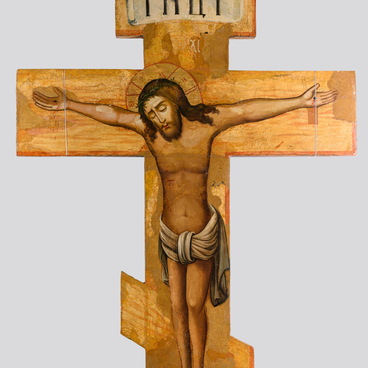The iconographic image of the Vladimir Mother of God is based on the Eleusa type (“Tenderness”). According to church tradition, the first Eleusa icon was created by Luke the Evangelist: he painted the image on a wooden tabletop in the house of Joseph the Betrothed, and Mary blessed the image with the words:
Vladimir Mother of God
Время создания
the late 19th century
Место создания
the Russian Empire
Размер
32x25 cm
Техника
wood, gesso, tempera
Коллекция
Выставка
0
Открыть в приложении#2
#3
From henceforth all generations shall call me blessed. Let the grace of Him who was born of Me and Mine be with this image.
#4
In addition to this original images, icon painters were inspired by the description of the Mother of God given in the early Christian apocrypha:
#5
The face was swarthy and oval, the hair was the color of ripe wheat, the lips were scarlet, the eyes were in the shape of almond fruits and the hands were thin.
#6
For a long time, a copy of the icon was kept in the Temple in Jerusalem; in the mid-5th century, Emperor Theodosius the Younger ordered the icon to be moved to Constantinople. From there in 1131, under Patriarch John IX Agapetos, it was presented as a gift to Prince Mstislav.
The prince placed the icon in the convent of Vyshgorod, where it remained until 1155 and became famous for its miracles.
Andrey Bogolyubsky took the sacred image with him to Vladimir and left it in the Assumption Cathedral. At that time, the icon acquired its second name — Vladimir Mother of God, or the Virgin of Vladimir. In 1164, through the prayers of Our Lady of Vladimir, the prince managed to defeat the Volga Bulgars. In 1185, the icon remained intact when a fire broke out in the Vladimir Cathedral, and in 1237 it survived the capture of Vladimir by Batu Khan.
The most famed miracle associated with the Vladimir image took place in 1395. Timur’s troops had already passed through Ryazan and were not far from Moscow. With the blessing of Metropolitan Cyprian, Muscovites remained in prayerful repentance and observed a fast, and prayer services were performed in front of the miraculous icon. Legend has it that Timur had a vision at that time: The Radiant Wife, surrounded by saints, descended from a high mountain and commanded him to leave Rus. Terrified, he led his troops away.
The iconographic type “Eleusa” is the most lyrical and at the same time sad of all Mary’s images. The Christ Child sits on His Mother’s right arm, hugging her neck. They embrace cheek to cheek, which conveys boundless love and the unity of the heavenly and earthly, the Church and Christ the High Priest, the soul and God, and at the same time the foresight of the coming sufferings on the cross and mourning.
The Vladimir image differs from other Eleusa icons in one touching detail — the left foot, the Baby’s heel, is turned to the worshiper.
The presented icon is one of the later copies of the miraculous image. It came to the museum from Nizhny Novgorod in 2005.
The prince placed the icon in the convent of Vyshgorod, where it remained until 1155 and became famous for its miracles.
Andrey Bogolyubsky took the sacred image with him to Vladimir and left it in the Assumption Cathedral. At that time, the icon acquired its second name — Vladimir Mother of God, or the Virgin of Vladimir. In 1164, through the prayers of Our Lady of Vladimir, the prince managed to defeat the Volga Bulgars. In 1185, the icon remained intact when a fire broke out in the Vladimir Cathedral, and in 1237 it survived the capture of Vladimir by Batu Khan.
The most famed miracle associated with the Vladimir image took place in 1395. Timur’s troops had already passed through Ryazan and were not far from Moscow. With the blessing of Metropolitan Cyprian, Muscovites remained in prayerful repentance and observed a fast, and prayer services were performed in front of the miraculous icon. Legend has it that Timur had a vision at that time: The Radiant Wife, surrounded by saints, descended from a high mountain and commanded him to leave Rus. Terrified, he led his troops away.
The iconographic type “Eleusa” is the most lyrical and at the same time sad of all Mary’s images. The Christ Child sits on His Mother’s right arm, hugging her neck. They embrace cheek to cheek, which conveys boundless love and the unity of the heavenly and earthly, the Church and Christ the High Priest, the soul and God, and at the same time the foresight of the coming sufferings on the cross and mourning.
The Vladimir image differs from other Eleusa icons in one touching detail — the left foot, the Baby’s heel, is turned to the worshiper.
The presented icon is one of the later copies of the miraculous image. It came to the museum from Nizhny Novgorod in 2005.
#7
Ministry of Culture of the Russian Federation
читать дальшескрыть
00:00
00:00
1x
Vladimir Mother of God
Время создания
the late 19th century
Место создания
the Russian Empire
Размер
32x25 cm
Техника
wood, gesso, tempera
Коллекция
Выставка
0
Открыть в приложении
Поделиться


